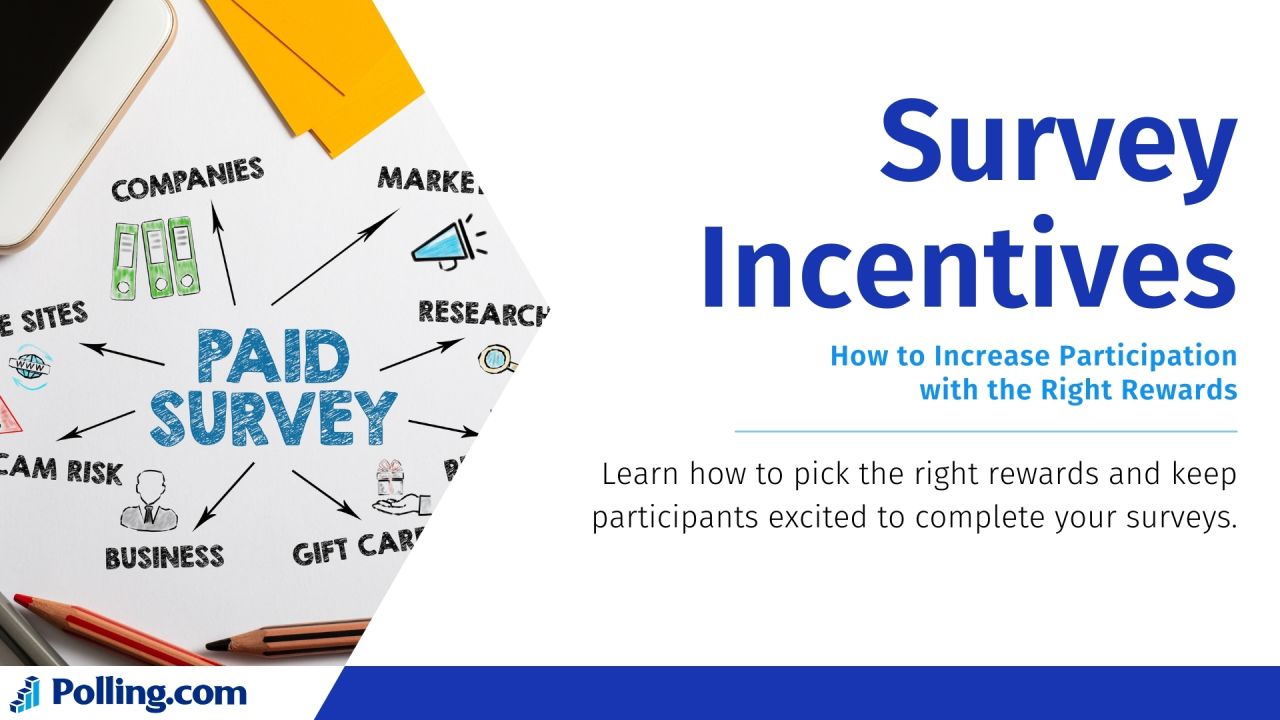
Survey Incentives: How to Increase Participation with the Right Rewards
In 2025, user feedback is the backbone of smarter decisions, whether it’s businesses fine-tuning products, political campaigns reading the room, or social researchers digging into what makes us tick.
But here’s the catch: most surveys hit a wall with low completion rates, as survey participants often ghost halfway through or skip altogether, leaving you with patchy data.
The fix? Offering rewards for survey participation can seriously boost your survey response rate. How to increase survey response rates starts with survey incentives that grab attention and keep respondents clicking.
With tools like Polling.com, you can easily build surveys with integrated incentive mechanisms, making it a snap to get the insights you need.
What Are Survey Incentives and Why Do They Work?
Survey incentives are more than just a nice gesture, they’re a game-changer for getting survey participants to show up and finish.
Definition and Purpose
So, what are survey incentives?
They’re rewards, like gift cards, discounts, or even a chance at a big prize, offered to encourage survey participants to complete a market research survey or any questionnaire.

It’s all about extrinsic motivation to complete surveys: in today’s digital attention economy, where everyone’s scrolling past a million distractions, a little nudge like “Finish this and get a $5 coupon” can spark action.
Incentives for survey participation tap into that human drive for a payoff, making respondents more likely to share their thoughts instead of bouncing. This is a key to boosting survey engagement without begging.
Data-Driven Impact on Participation Rates
Do survey incentives improve response rate? The data says yes.
A Gallup study found that small cash incentives, like $2-$5 mailed upfront, can boost survey response rates by 10-20% in mail and web surveys, pulling in more survey participants who might otherwise skip out.
Similarly, a 2019 BMC Medical Research Methodology review showed that monetary rewards in health surveys lifted participation by up to 11.4%, especially when tailored to the audience.
Imagine a market research survey limping along at 10% completion. You toss in a $5 gift card, and you could hit 25% or more, making offering rewards for survey participation a no-brainer for better data.
When to Consider Using Survey Incentives
Some surveys just beg for a little extra push to reel in respondents, and that’s where survey incentives shine.
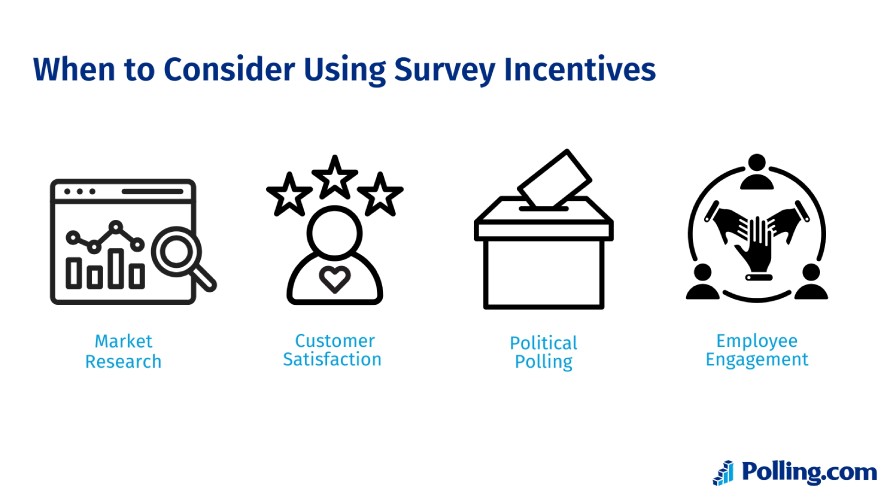
Market research surveys are first on the list. Let’s say a company is testing a new snack, and a small reward like a coupon can get picky eaters to share what they love or hate, boosting your data haul.
Then there’s customer satisfaction. For example, an NPS survey with a discount code might nudge survey participants to finish, giving you a clearer read on loyalty.
Political polling is another hot spot. You toss in a gift card to draw out quieter voices, especially in tight races, for a fuller picture of the vibe.
And don’t forget employee engagement. Offering participant rewards, like a chance at a bonus, can get your team to open up about what’s working or not.
The 4 Most Effective Types of Survey Incentives
Not all survey incentives are created equal. Here are four types that really move the needle on survey response rate, each with its own advantage for pulling in survey participants.
1. Monetary Incentives
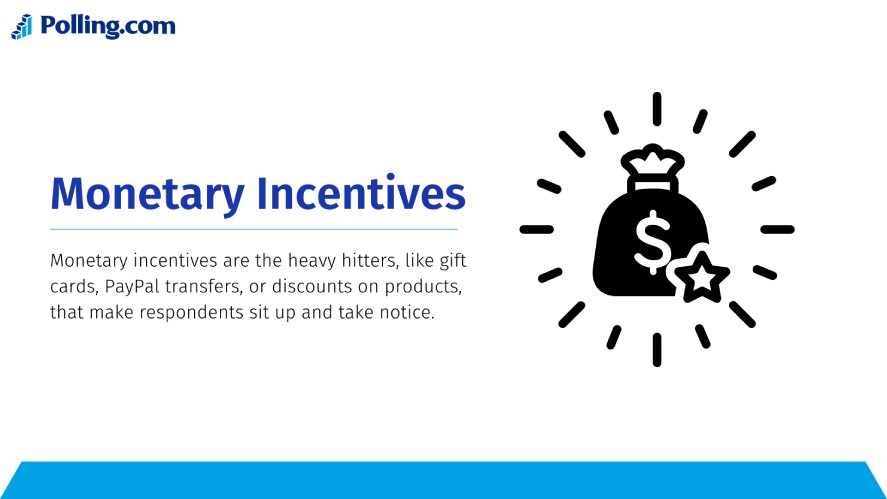
Monetary incentives are the heavy hitters, like gift cards, PayPal transfers, or discounts on products, that make respondents sit up and take notice.
A $5 Amazon voucher or 10% off their next buy can work wonders, especially for B2C audiences or product feedback surveys where you’re digging into what respondents think of your latest gadget.
These rewards are a top pick among best survey incentive ideas for market research surveys, boosting completion fast.
Polling.com makes this seamless, as it can auto-issue digital rewards securely, so you’re not stuck emailing codes or chasing down survey participants.
2. Non-Monetary Incentives
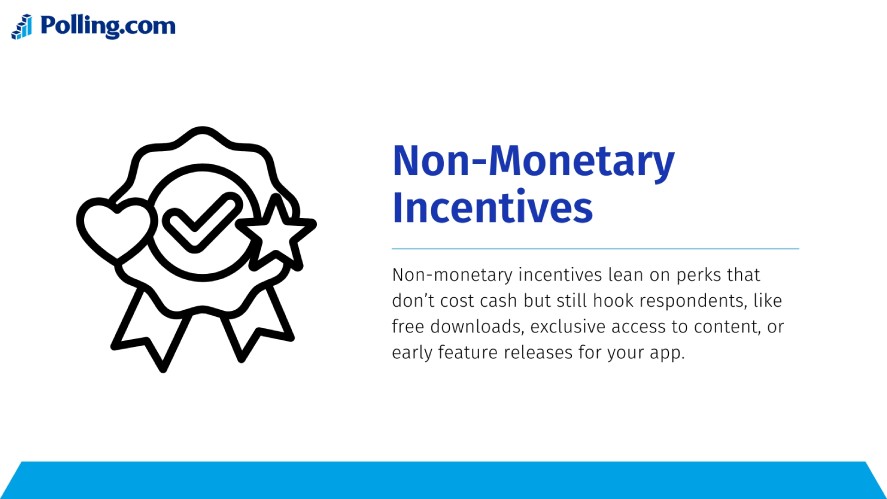
Non-monetary incentives lean on perks that don’t cost cash but still hook respondents, like free downloads, exclusive access to content, or early feature releases for your app.
Imagine offering a premium eBook for finishing a survey or a sneak peek at your next product drop. These build long-term survey engagement, especially with content-driven brands like blogs or SaaS companies.
They’re a smart play in incentives for survey participation when you want survey participants coming back, not just one-and-done.
Among types of survey incentives, these shine for fostering loyalty without breaking the bank, giving respondents something cool to brag about.
3. Prize Drawings & Sweepstakes
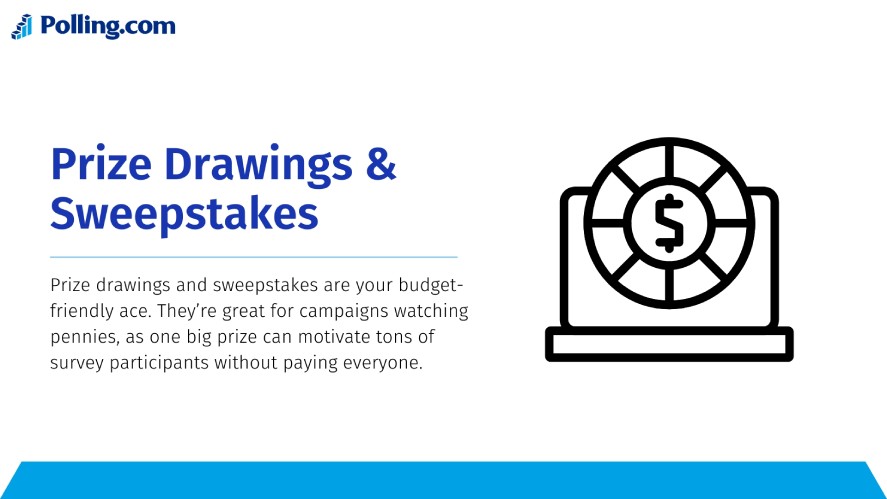
Prize drawings and sweepstakes are your budget-friendly ace. They’re great for campaigns watching pennies, as one big prize can motivate tons of survey participants without paying everyone.
Prize draws for respondents work well for market research or quick polls but need clear legal disclosures, like “No purchase necessary, winners picked randomly”, to stay above board.
Offering rewards for survey participation this way can spike survey response rates, but you’ve got to nail the winner selection process to keep it fair and avoid gripes, making it a flashy but tricky best survey incentive idea.
4. Charitable Donations
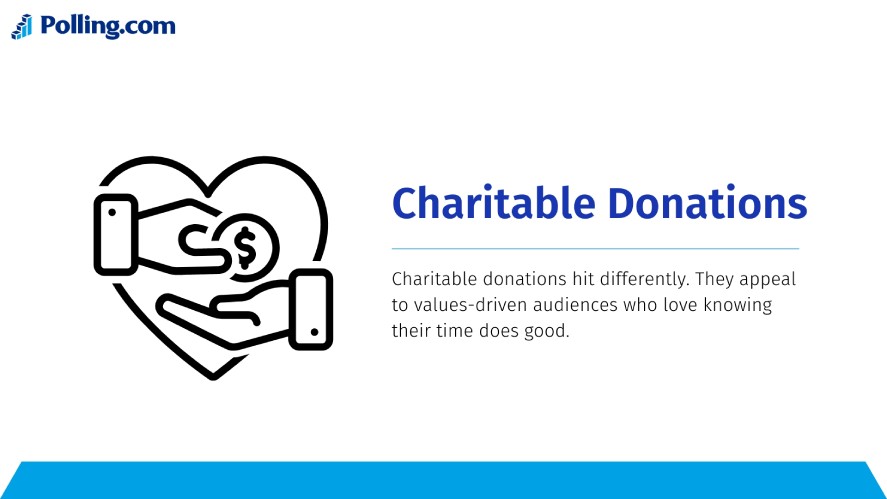
Charitable donations hit differently. They appeal to values-driven audiences who love knowing their time does good.
Try “For every response, we’ll donate $1 to a local food bank”. It’s a feel-good nudge that boosts survey response rate for causes respondents care about, like environmental or community projects.
This one is a gem for socially conscious brands running market research surveys, as it aligns with what survey participants value over cash.
Among survey incentives, it’s less about getting paid to take surveys and more about shared purpose, turning a simple click into something bigger.
How to Choose the Right Incentive for Your Audience
Picking the perfect survey incentives isn’t one-size-fits-all, it’s about knowing who’s filling out your market research survey and what will get them to hit the submit button.
Here’s how to nail it.
Match Incentive Type to Demographics
Your audience’s vibe sets the tone for what works, so match incentives for survey participation to their demographics for maximum pull.
Young respondents, like Gen Z or millennials, go nuts for digital gift card giveaways or subscriptions. So, a $5 or a month of premium streaming can skyrocket survey response rate for a quick poll.
Professionals, like execs or B2B respondents, might lean toward charitable donation options or exclusive reports. For example, a message like “Complete this and get our industry insights PDF” feels high-value without being flashy.
For employees, internal recognition, like a shoutout in a company newsletter, or small bonuses hit home, turning a dull survey into a feel-good moment.
Getting this right means survey participants see the reward as something they actually want.
Consider Survey Length and Complexity
Survey length and complexity play a big role, as longer or trickier surveys need better rewards to keep survey engagement up.
A five-minute “Rate our app” might only need a $1 coupon, but you’ll need a $10 gift card for a 20-minute deep-dive questionnaire.
Offering rewards for survey participation that match the effort is key, as nobody is slogging through brain-benders for a measly sticker.
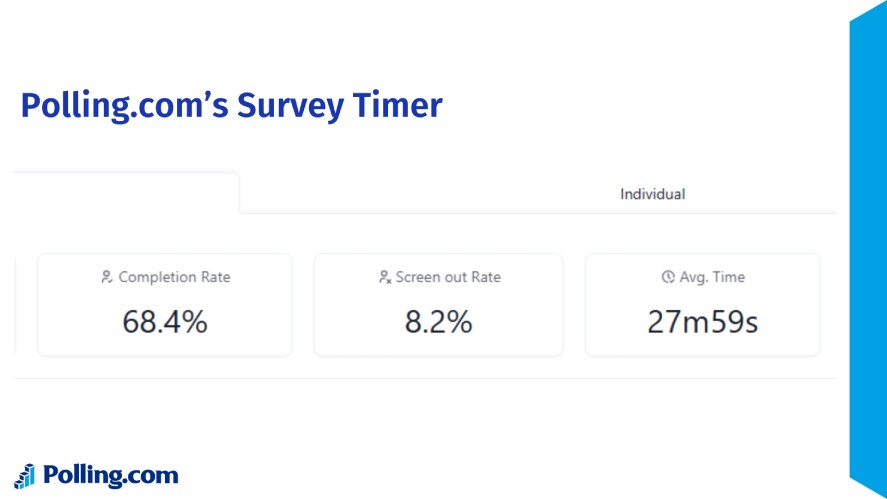
Tip: Use Polling.com’s survey timer to assess response time and align the incentive’s value to keep survey participants happy to finish.
Understand Your Budget & Scalability
Budget is the reality check. Knowing fixed versus variable cost models helps you scale without going broke.
Fixed costs, like a set prize for sweepstakes, work for big groups but cap rewards. Variable ones, like $2 per response, flex with your crowd but can balloon fast.
Set incentive caps, like “First 500 get a gift card”, to stay in control, and lean on automation tools to avoid manual chaos.
Polling.com is a lifesaver here. Its feature for auto-distributing digital rewards keeps offering rewards for survey participation smoothly, even for thousands of survey participants. It saves you cash and headaches while boosting your market research survey’s reach.
Best Practices for Implementing Incentives in Surveys
Rolling out survey incentives the right way can make or break how to increase survey response rates. Here’s how to do it smart and keep survey participants happy.
Be Transparent From the Start
First off, be crystal clear about your survey incentives. Tell survey participants exactly what they’re getting, how it works, and when they’ll see it.
For example, try wording like: “Complete this 5-minute survey for a chance to win a $50 Amazon gift card. Winners notified by email within a week!”.
This survey incentive sets expectations and builds trust, so nobody’s left wondering if it’s a scam.
This clarity is a top best survey incentive idea. It shows respondents you’re upfront, boosting survey engagement by making the reward feel real and reachable, not some vague promise.
Offer Incentives Ethically
Incentives for survey participation need to feel fair, not pushy. You should avoid manipulative phrasing like “You’d be crazy to skip this $10 reward!” since that sounds coercive.
Data collection is going to stay voluntary and informed. So, let respondents know their answers are private and optional, especially in sensitive areas like healthcare, political polling, or academic market research surveys.
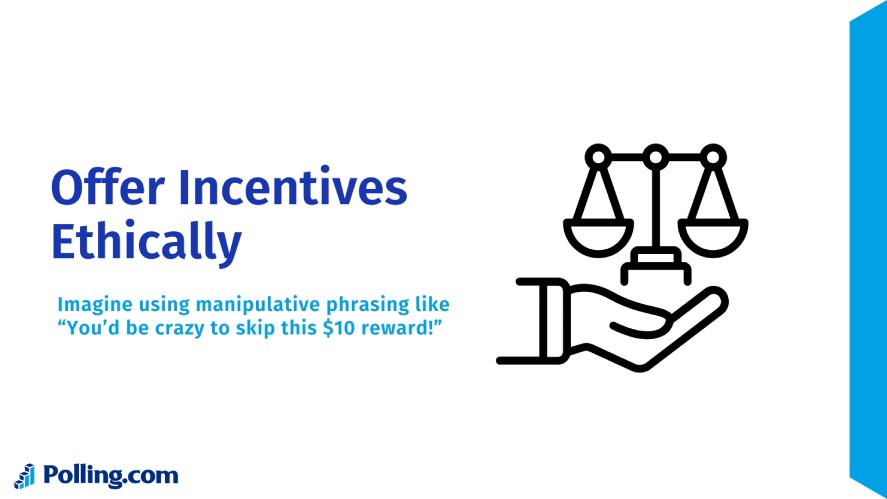
Moreover, ethical offering rewards for survey participation is critical.
What’s the point of a high survey response rate if respondents feel tricked? This keeps your data legit and your survey participants respected.
Decide When to Distribute the Incentive
Timing your incentive drop matters.
Pre-incentives, like sending $2 upfront, can grab attention but promised incentives, delivered after completion, often work better for data integrity.
Pre-incentives risk half-hearted answers, while post-survey rewards tie the payoff to effort, making them a solid pick for market research.
Either way, survey incentives improve response rate, but waiting until the end keeps your insights better.
How Polling.com Helps You Deliver Survey Incentives Easily
Getting survey incentives to survey participants smoothly can make or break your survey response rate. And Polling.com has the tools to make it a breeze.
Built-In Reward Tools with Automation
Polling.com has built-in tools that track completions and give out incentives automatically so no need to chase down respondents or juggle spreadsheets.
Whether you’re handing out gift cards, cash, or discounts, it’s compatible with PayPal and Stripe for slick digital payouts.

Let’s say you’re running a market research survey promising $5 per finish. Polling.com spots the completed survey, fires off the reward, and you’re done.
This automation is a game-changer, saving time and keeping survey engagement high by ensuring survey participants get paid to take surveys without delay.
Analytics Dashboard to Track Incentive ROI
Want to know if your incentives are worth it? Polling.com’s analytics dashboard shows real-time results like completion rates, drop-off points, and cost per response, so you can see exactly how your rewards boost survey response rates.
You can even A/B test different incentive types, like $5 versus a sweepstakes entry, to find what pulls the most responses for your buck.
This kind of insight makes Polling.com a standout for tweaking survey incentives and nailing your return on investment.
Comparison with Other Tools
Not all survey platforms handle incentives like Polling.com. Here’s how it stacks up:
| Feature | Polling.com | SurveyMonkey | Typeform | Google Forms |
|---|---|---|---|---|
| Incentive Automation | ✅ Yes | ❌ Manual | ❌ Manual | ❌ Not Available |
| Response Tracking | ✅ Real-time | ✅ | ✅ | ✅ |
| Cost Optimization | ✅ Built-in | ❌ | ❌ | ✅ Basic |
SurveyMonkey and Typeform let you track responses but leave you handling incentives manually, which kills time.
What about Google Forms? It’s got basic tracking and cost-free vibes, but no incentive system at all, so you’re on your own for rewards.
Polling.com’s edge is its all-in-one setup, making incentives for survey participation a smooth, data-driven win for any survey engagement goal.
Common Mistakes When Using Incentives in Surveys
Survey incentives can supercharge your survey response rate, but slip-ups in how you roll them out can mess things up.
Here are three big mistakes to avoid for better survey engagement.
Over-Incentivizing (Attracting “Freebie” Respondents)
Going overboard with survey incentives, like offering a $50 gift card for a two-minute poll, can backfire by pulling in freebie respondents who just want the reward, not to give honest answers in paid surveys.
This floods your market research survey with low-quality or even fraudulent responses, like speed-clickers faking their way to the prize, tanking your data’s value.
Fortunately, Polling.com helps dodge this trap with user validation tools, keeping your survey participants legit.
Poor Communication of Terms
Nothing sours survey engagement faster than murky terms. Let’s say you promise a coupon but don’t explain when or how it arrives, leaving respondents confused or feeling scammed.

That distrust can destroy survey response rates next time around. So, be upfront and straightforward with a message like “Finish this 5-minute survey, and we’ll email your $3 voucher within 24 hours”.
Clear timing and delivery details in your incentives for survey participation pitch build trust, so survey participants know exactly what’s coming and stay happy to participate in your next survey.
Ignoring Legal Requirements
Skimping on legal stuff is a rookie mistake, especially with contests, sweepstakes, or international crowds.
Offering rewards for survey participation like “Enter to win an iPad!” sounds fun, but you’re asking for trouble without disclaimers or clear eligibility rules. Some countries have strict reporting obligations too, like tax forms for cash prizes.
Ignoring these can derail your survey process, especially for global or sensitive surveys. So, spell it all out in your terms to keep your survey incentives clean and your survey participants confident they’re in a fair game.
How to Measure the Success of Your Survey Incentive Strategy
You’ve rolled out survey incentives. Now how do you know if they’re working to boost survey engagement?
Here’s the playbook for measuring what’s hitting and what’s not with survey participants.
Key Metrics to Track
Start with survey response rate. Let’s say your market research survey gets 30% of invited respondents to start, and that’s your first clue on pull.
Then check completion rate: if only 15% finish, something’s off, but a high rate like 80% shows success.
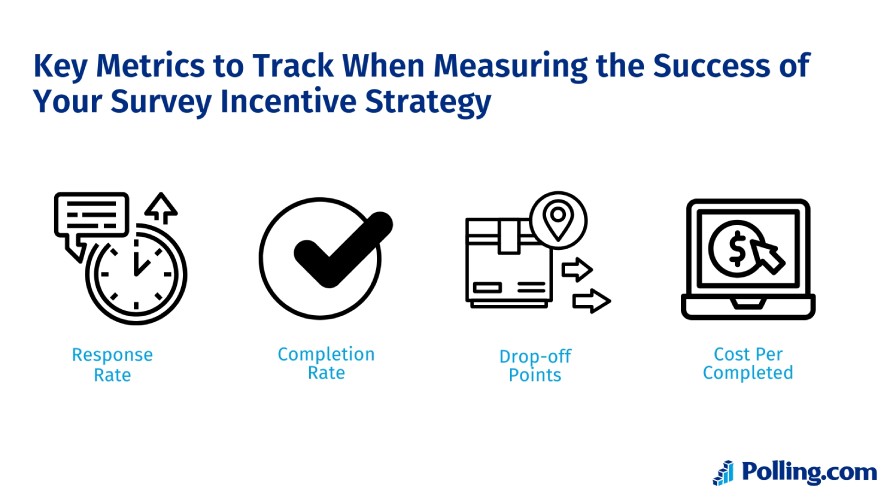
Drop-off points tell you where respondents bail, maybe question 10 is a slog, which needs to be removed.
And don’t skip cost per completed survey. Divide your total incentive spend, like $500 in gift cards, by completions, say 200, for $2.50 each. It shows if your best survey incentive ideas are worth the cash.
These metrics reveal how to increase survey response rates without guessing.
Use A/B Testing to Optimize
A/B testing is your secret weapon. Try different incentives for survey participation across respondent segments to see what pops.
For example, a $5 voucher versus a sweepstakes entry for “How’s our product?”.
Remember, compare not just quantity, but response quality, like whether answers feel thoughtful or rushed. Maybe professionals give richer feedback for a report over cash, while younger respondents dig digital coupons.
This sharpens your market research survey, letting you tweak offering rewards to get the most out of it, not just a flood of poor-quality replies.
Retention vs. One-Off Engagement
Are your survey participants one-and-done, or do they come back? Great incentives can build a feedback loop, not just a quick win.
If you’re offering rewards for survey participation like exclusive perks, track if they return for your next poll.
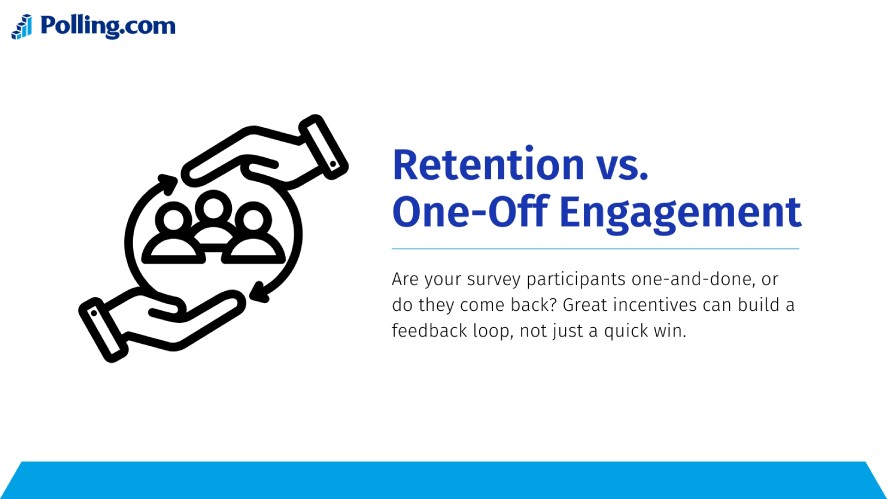
Moreover, use incentives as part of a loyalty strategy, like points for each survey that add up to bigger rewards, turning get paid to take surveys into a habit.
This long-game focus boosts survey engagement over time, making your crowd a reliable crew for future market research.
Make Every Survey Count With Smart Incentives
Incentive-based surveys can transform your survey response rate, but only if you play them right.
Picking the wrong reward can leave you with junk data and annoyed survey participants. But if done well, they can pull in respondents and make your market research survey shine, giving you insights you can actually trust.
Choosing the best survey incentive ideas means knowing your audience and leaning on a platform that makes it easy to deliver.
Ready to improve your survey performance? Try Polling.com’s incentive-ready survey builder today and watch your next market research effort hit new heights.
